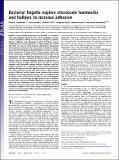| dc.contributor.author | Friedlander, Ronn Samuel | |
| dc.contributor.author | Vlamakis, Hera | |
| dc.contributor.author | Kim, Philseok | |
| dc.contributor.author | Khan, Mughees | |
| dc.contributor.author | Kolter, Roberto | |
| dc.contributor.author | Aizenberg, Joanna | |
| dc.date.accessioned | 2013-12-30T16:49:34Z | |
| dc.date.available | 2013-12-30T16:49:34Z | |
| dc.date.issued | 2013-03 | |
| dc.date.submitted | 2012-11 | |
| dc.identifier.issn | 0027-8424 | |
| dc.identifier.issn | 1091-6490 | |
| dc.identifier.uri | http://hdl.handle.net/1721.1/83364 | |
| dc.description.abstract | Biofilms, surface-bound communities of microbes, are economically and medically important due to their pathogenic and obstructive properties. Among the numerous strategies to prevent bacterial adhesion and subsequent biofilm formation, surface topography was recently proposed as a highly nonspecific method that does not rely on small-molecule antibacterial compounds, which promote resistance. Here, we provide a detailed investigation of how the introduction of submicrometer crevices to a surface affects attachment of Escherichia coli. These crevices reduce substrate surface area available to the cell body but increase overall surface area. We have found that, during the first 2 h, adhesion to topographic surfaces is significantly reduced compared with flat controls, but this behavior abruptly reverses to significantly increased adhesion at longer exposures. We show that this reversal coincides with bacterially induced wetting transitions and that flagellar filaments aid in adhesion to these wetted topographic surfaces. We demonstrate that flagella are able to reach into crevices, access additional surface area, and produce a dense, fibrous network. Mutants lacking flagella show comparatively reduced adhesion. By varying substrate crevice sizes, we determine the conditions under which having flagella is most advantageous for adhesion. These findings strongly indicate that, in addition to their role in swimming motility, flagella are involved in attachment and can furthermore act as structural elements, enabling bacteria to overcome unfavorable surface topographies. This work contributes insights for the future design of antifouling surfaces and for improved understanding of bacterial behavior in native, structured environments. | en_US |
| dc.description.sponsorship | United States. Office of Naval Research (Award 00014-11-1-0641) | en_US |
| dc.description.sponsorship | Harvard University. BASF Advanced Research Initiative | en_US |
| dc.description.sponsorship | National Science Foundation (U.S.). Graduate Research Fellowship Program | en_US |
| dc.description.sponsorship | National Science Foundation (U.S.) (Award ECS-0335765) | en_US |
| dc.language.iso | en_US | |
| dc.publisher | National Academy of Sciences (U.S.) | en_US |
| dc.relation.isversionof | http://dx.doi.org/10.1073/pnas.1219662110 | en_US |
| dc.rights | Article is made available in accordance with the publisher's policy and may be subject to US copyright law. Please refer to the publisher's site for terms of use. | en_US |
| dc.source | PNAS | en_US |
| dc.title | Bacterial flagella explore microscale hummocks and hollows to increase adhesion | en_US |
| dc.type | Article | en_US |
| dc.identifier.citation | Friedlander, R. S., H. Vlamakis, P. Kim, M. Khan, R. Kolter, and J. Aizenberg. “Bacterial flagella explore microscale hummocks and hollows to increase adhesion.” Proceedings of the National Academy of Sciences 110, no. 14 (April 2, 2013): 5624-5629. | en_US |
| dc.contributor.department | Whitaker College of Health Sciences and Technology | en_US |
| dc.contributor.department | Harvard University--MIT Division of Health Sciences and Technology | en_US |
| dc.contributor.mitauthor | Friedlander, Ronn Samuel | en_US |
| dc.relation.journal | Proceedings of the National Academy of Sciences | en_US |
| dc.eprint.version | Final published version | en_US |
| dc.type.uri | http://purl.org/eprint/type/JournalArticle | en_US |
| eprint.status | http://purl.org/eprint/status/PeerReviewed | en_US |
| dspace.orderedauthors | Friedlander, R. S.; Vlamakis, H.; Kim, P.; Khan, M.; Kolter, R.; Aizenberg, J. | en_US |
| mit.license | PUBLISHER_POLICY | en_US |
| mit.metadata.status | Complete | |
